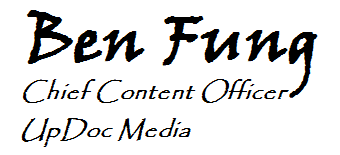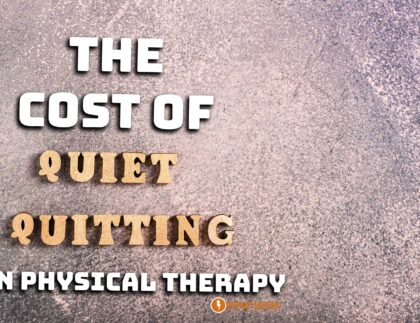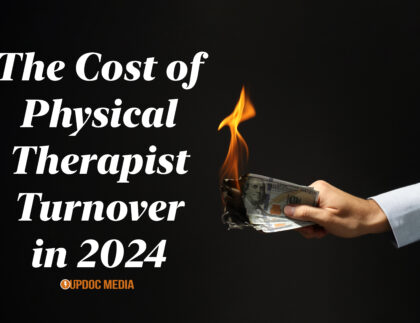

Greetings everyone and welcome to Part 5 of 5 of our special series on the 2015 Physical Therapy Job Market Outlook. We’ve covered a survey of state-by-state salary expectations, tips on negotiating your salary, resume tips, and strategies on approaching student debt, Now, it is finally to cover the long term approach of how to navigate your career path now that everything else is all locked in.
New Grad Career Strategies
There are 3 fundamental problems present to the new grad:
- Need experience to get experience.
- Job desperation yields an easy victim to low starting salaries.
- Blunted organizational opportunities means limited upward mobility.
Here are our strategic solutions for the new grad career path:
Problem #1 Need experience to get experience.
Solution Strategy: Get In, Get In Anywhere & Make Money
This is a two in one problem. First, new grads have loans. Not making money is not an option so it is a scramble to find a job fast. And, of course, the stability of a full time job is standard, accepted, and safe, making it an ideal place to start looking. Secondly, all new grads are faced with the ironic conundrum of needing experience to get it. Many companies want clinicians with 2-3 years of experience at entry level. However, those clinicians are already at stable full time jobs. These same companies don’t really want to look at an inexperienced new grad which causes the new grad to be otherwise stuck with poor hiring prospects until they settle for a less than favorable position, less than favorable pay, or both. The fact is, many employers traditionally assume that:
- You don’t know anything because you are a “new grad.”
- Therefore, they shouldn’t pay you all that much since you “still learning.”
- And, since you have zero “experience,” there is no where else you can go for work to pay off your student loans. As such, many employers assume they can bully you into accepting any position for terrible pay.
Not only is that entirely backwards, I’m here to tell you that “they”… are WRONG.
There are several segments of work that pay handsomely well and will offer you the exposure & experiences you need to raise your personal brand equity as a physical therapist. Home health agencies, contract work for skilled nursing facilities, general registry companies, and travel agencies all offer pay which is immensely superior to the common 40 hour work week in acute care, acute rehab, pediatrics, and/or outpatient. In fact, the pay grade at such aforementioned opportunities tend to be comparable to time-and-a-half of the typical entry-level pay for larger health system positions.
Therefore, to get experience, you need to get in and get in anywhere at all. Find per diem, staffing opportunities, and travel opportunities to demonstrate your versatile abilities as well as your multi-dimensional experience. Also, keep in mind that per diem positions and staffing opportunities are a savvy way hiring managers test out potential full time candidates. I’ve seen many part time and staffing employees convert into full time positions because they demonstrated better work ethics and a stronger sense of team excellence than incumbents. Good managers will capitalize on this and even try to match top dollar to elevate their team culture for long term organizational benefits. And, on that note of why PRN work is certainly worth consideration, here is an excellent post on why per diem works for the new graduated and fresh PTs out there — after all, full time isn’t everything!
Problem #2: Job desperation yields an easy victim to low starting salaries.
Solution Strategy: Make Money. Get Out!
Given that new grads presently in 2015 are generally being hired in at less than $40 per hour, some less than $35, and even some less than $30 to the hour… the prospects of paying off student loans and earning a living gets bleaker by the moment. The good news is that following the first strategy above, new graduates can simultaneously find a personal combination of per diem and staffing positions which pay upwards of $40+/hour. Also, you can use the same pay grades as your next stepping stone when you quite your first full time job.
That’s right. You read that correctly. I want you to QUIT!
Quitting your first full time job relatively early in your career path can be a very a good thing. Personally, I took raises each time I quit a job as each successive hiring manager saw me not as the “new grad,” but as an increasingly experienced clinician who has accomplished much in a very small amount of time. This phenomenon with your original hiring manager seeing you as “nothing but a student” is universal to all industries. And, the following effect of the next hiring manager viewing you as much more of a seasoned professional is in the same vein and happens everywhere you go. Moreover, it’s been very well established that changing jobs every two years causes any given employee to stand to gain around 50% of salary increase.
So, quitting? It’s not such a bad thing. In fact, it’s entirely strategic.
The reality is, to make good money: work for someone who values your labor, NOT your education. Get into a job, ANY job. Gain about 2-4 years of experience and get out. Three years seems to be the magic number in our current job market. Nevertheless, the key is you must get OUT in that time if you are to take advantage of this effect to sequentially boost your pay grade beyond the standard yearly raises and finally get paid what you are truly worth.
Following this strategy, a new grad physical therapist can easily jump from $30/hour to $35/hour in 2 years. Then, from $35/hour to $40+ in the next couple years. And, I’ll be perfectly transparent: I did this, it worked, and I was getting paid nearly $50/hour in my last clinical job.
You can defeat the curse of the low ball pay grade in the very same way.
Problem #3: Blunted organizational opportunities means limited upward mobility.
Solution Strategy: Stick Around, Get Credentialed, and Strike When The Iron Is HOT!
If you look at the physical therapists who have risen the ranks to health system leadership, nearly all of them have some type of business background, business degree, or a non-clinical business credential. Whether it is an MBA, MPH, MHA, CPA, Six-Sigma, etc. these additional credentials serve as power boosters which elevate employees beyond the “just a clinician” perception.
Business means money, and, money means leadership.
Therefore, once you’ve found an organization (or company type) to hang your hat, do your best to stick around and make a LOT of alliances across every business unit you can interact with. Make friends with your own colleagues, their managers, the staff and bosses of other disciplines, and try to get yourself into ad hoc committees visible to middle and senior management.
This is a good way to avoid intra-professional degradation as is ridiculously familiar to physical rehab professionals as they overtly bash on their new colleagues for graduating with shiny degrees. This is also a good way of staying under the radar through strong alliances so you can pursue some business credentials in relative peace.
Opportunities along the life-cycles of organizational management will offer up opportunities every 3 years, every 5 years, and every 10 years. Typically, supervisory jobs requires 5 years of experience and anything middle management or above requires 10 years. 3 years is typically the requirement for the first promotion; however, many organizations are starting to accept 2 years.
All this to say, if you stick around long enough and have the right non-clinical credentials when the time comes, the opportunity will highlight you better than you could highlight the opportunity for yourself. When the iron is hot, strike and strike true!
A word of advice: Dig up the job requirements for the upward opportunities you have in mind and specifically seek out the associated credentials or required experiences. Also, make sure you keep a monthly view on the job market in your region so you can get a good feel for where the industry is going in terms of its need for leadership. This way, you can keep an eye out for which business credentials are most popularly required or desired. And, through this manner, you may find an opportunity at another organization you can jump into or upwards depending on your situation.
One Last Thing
I hope you enjoyed this special 5 part job market outlook blog series. Personally, I relished all the private messages, emails, tweets, and all interactions following each post. You make this job way too much fun!
And so, we here at UpDoc Media were thinking, perhaps we should close this series with a little encore: a special webinar on interview tips, tactics, and strategies. Let us know what you think!
Until next time, I remain yours in service,










